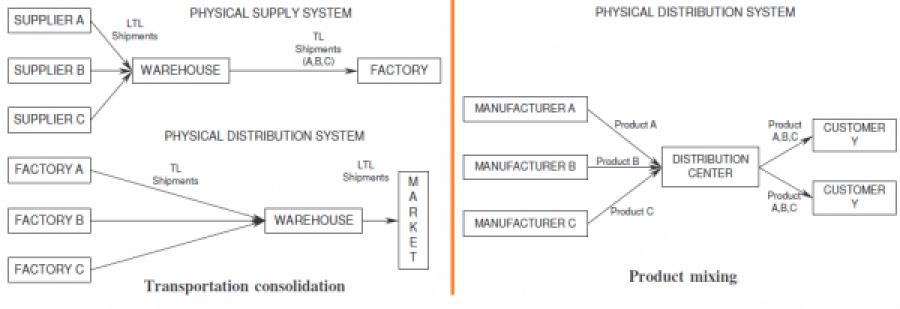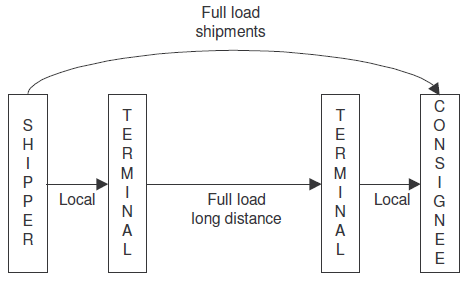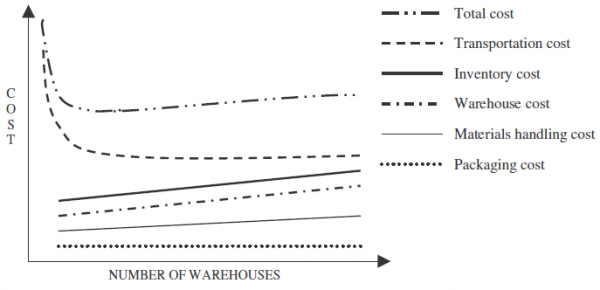Transportation
Transport or transportation is the movement of people, cattle, animals and goods from one location to another.Transport is important since it enables trade between peoples, which in turn establishes civilizations.
By making a product available at a particular point in the distribution system, it adds place value to the product. On a broader perspective, transportation contributes to the social and economic development. There are basically five modes of transportation
Rail
Road
Air
Water
Pipeline
Costs of carriage
To provide transportation service, any carrier must have certain basic physical lements. These elements are ways, terminals and vehicles. Each results in a cost to the carrier and, depending on the mode and the carrier, may be either capital (fixed) or operating (variable) costs. Fixed costs are costs that do not change with the volume of goods carried. The purchase cost of a truck is a fixed cost. However, many costs of operation, such as fuel, maintenance and driver’s wages, depend on the use made of the truck. These are variable costs.
Ways are the paths over which the carrier operates. The nature of the way and how it is paid vary with the mode. They may be owned and operated by the government or by the carrier or provided by the nature.
Terminals are places where carriers load and unload goods to and from vehicles and make connections between local pickup and delivery service and linehaul service. Other functions performed at terminals are weighing; connections with other routes and carriers; vehicle routing, dispatching and maintenance; and administration and paperwork. The nature, size and complexity of the terminal varies
with the mode and size of the firm and the types of good carried. Terminals are generally owned and operated by the carrier but, in some special circumstances, may be publicly owned and operated.
Vehicles of various types are used in all modes except pipelines. They serve as carrying and power units to move the goods over the ways. The carrier usually owns or leases the vehicles, although sometimes the shipper owns or leases them.
Rail
Railways provide their own ways, terminals and vehicles, all of which represent a large capital investment. This means that most of the total cost of operating a railway is fixed. Thus, railways must have a high volume of traffic to absorb the fixed costs. Therefore, railways are best able to move large volumes of bulky goods over long distances.
Rail speed is good over long distances, the service is generally reliable and trains are flexible about the goods they can carry. Train service is cheaper than road for large quantities of bulky commodities moved over long distances.
Although the rail mode of transportation has the advantages of large volume transportation over long distances, less per unit transportation costs compared to the other modes, good transportation speed over long distances, reliable service, flexibility in the
types of goods carried, etc., it has certain drawbacks as listed below :
They operate on specific predetermined time schedules and hence the frequency and transit times are not flexible.
They operate between their terminals and hence cannot provide a stock-point to stock-point type of service
Unlike the road transport, general availability at the required locations and at the required times cannot be guaranteed.
Road
Trucks do not provide their own ways but pay a fee to the government as license, gasoline and other taxes and tolls for the use of roads. Terminals are usually owned and operated by the carrier but may be either privately owned or owned by the government. If owned, they are a major capital expense. However, in comparison to other modes, the cost of a vehicle is small. This means that for road carriers most of
their costs are operating (variable) in nature.
Trucks can provide door-to-door service. They are particularly suited to distribution of relatively small-volume goods to a dispersed market.
Air
Air transport requires an airway system that includes air traffic control and navigation systems. These systems are usually provided by the government. Carriers pay a user charge that is variable cost to them. Terminals include all of the airport facilities, most of which are provided by the government. However, carriers are usually responsible for providing their own cargo terminals and maintenance facilities,
either by owning or renting the space. The aircraft are expensive and are the single most important cost element for the airline. Since operating costs are high, airlines’ costs are mainly variable.
The main advantage of air transport is speed of service, especially over long distances. Most cargo travels in passenger aircraft and thus many delivery schedules are tied to those of passenger service. Transportation cost for air cargo is higher than for a other modes. For these reasons, air transport is most often suitable for high-value,
low-weight cargo or for emergency items.
Water
Waterways are provided by nature or by nature with assistance of the government. The carrier thus has no capital cost in providing the ways but may have to pay a fee for using the waterway. Terminals may be provided by the government but are increasingly privately
owned. The carrier will pay a fee to use them. Thus, terminals are mainly a variable cost. Vehicles are either owned or leased by the carrier and represent the major capital or fixed cost to the carrier.
The main advantage of water transport is cost. Operating costs are low and, since the ships have a relatively large capacity, the fixed costs can be absorbed over large volumes. Ships are slow and are door-to-door only if the shipper and the consignee are on the waterway. Therefore, water transportation is most useful for moving low-value, bulky cargo over relatively long distances where waterways are
available.
Pipelines
Pipelines are unique among the modes of transportation in that they move only gas, oil and refined products on a widespread basis. Capital costs for ways and pipelines are high and are borne by the carrier, but operating costs are very low.




